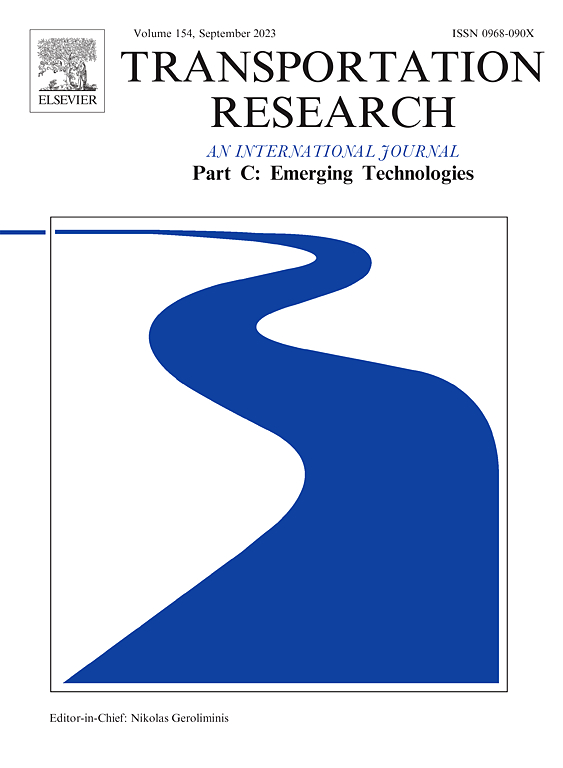通过对不确定的人类行为主动做出反应,实现安全感知的人导车排序
IF 7.6
1区 工程技术
Q1 TRANSPORTATION SCIENCE & TECHNOLOGY
Transportation Research Part C-Emerging Technologies
Pub Date : 2024-11-21
DOI:10.1016/j.trc.2024.104941
引用次数: 0
摘要
人车协同自适应巡航控制(HL-CACC)被认为是一种在实际应用中很有前途的车辆排成一排的技术。通过利用人类驾驶车辆(HV)作为排头兵,HL-CACC 降低了成本,提高了感知和决策的可靠性。然而,由于没有考虑领队人类驾驶员的不确定行为,最先进的 HL-CACC 技术在驾驶安全性方面仍有很大的局限性。本研究基于随机模型预测控制(SMPC)设计了一种 HL-CACC 控制器。它能够预测领先的互联人类驾驶车辆(CHV)的驾驶意图。所提出的控制器具有以下特点:(i) 增强了震荡交通中的感知安全性;(ii) 保证了急刹车时的安全性;(iii) 实时执行的计算效率。在 PreScan&Simulink 仿真平台上对所提出的控制器进行了评估。为校准仿真,收集了真实的车辆轨迹数据。结果表明,所提出的控制器:(i) 在振荡交通中提高了 19.17% 的感知安全性;(ii) 在硬刹车时提高了 7.76% 的实际安全性;(iii) 具有字符串稳定性。在配备英特尔 i5-13500H CPU 的笔记本电脑上运行时,计算时间约为 3.2 毫秒。这表明所提出的控制器可用于实时实施。本文章由计算机程序翻译,如有差异,请以英文原文为准。
Safety-aware human-lead vehicle platooning by proactively reacting to uncertain human behaving
Human-Lead Cooperative Adaptive Cruise Control (HL-CACC) is regarded as a promising vehicle platooning technology in real-world implementation. By utilizing a Human-driven Vehicle (HV) as the platoon leader, HL-CACC reduces the cost and enhances the reliability of perception and decision-making. However, state-of-the-art HL-CACC technology still has a great limitation on driving safety due to the lack of considering the leading human driver’s uncertain behavior. In this study, a HL-CACC controller is designed based on Stochastic Model Predictive Control (SMPC). It is enabled to predict the driving intention of the leading Connected Human-Driven Vehicle (CHV). The proposed controller has the following features: (i) enhanced perceived safety in oscillating traffic; (ii) guaranteed safety against hard brakes; (iii) computational efficiency for real-time implementation. The proposed controller is evaluated on a PreScan&Simulink simulation platform. Real vehicle trajectory data is collected for the calibration of the simulation. Results reveal that the proposed controller: (i) improves perceived safety by 19.17 % in oscillating traffic; (ii) enhances actual safety by 7.76 % against hard brakes; (iii) is confirmed with string stability. The computation time is approximately 3.2 ms when running on a laptop equipped with an Intel i5-13500H CPU. This indicates the proposed controller is ready for real-time implementation.
求助全文
通过发布文献求助,成功后即可免费获取论文全文。
去求助
来源期刊
CiteScore
15.80
自引率
12.00%
发文量
332
审稿时长
64 days
期刊介绍:
Transportation Research: Part C (TR_C) is dedicated to showcasing high-quality, scholarly research that delves into the development, applications, and implications of transportation systems and emerging technologies. Our focus lies not solely on individual technologies, but rather on their broader implications for the planning, design, operation, control, maintenance, and rehabilitation of transportation systems, services, and components. In essence, the intellectual core of the journal revolves around the transportation aspect rather than the technology itself. We actively encourage the integration of quantitative methods from diverse fields such as operations research, control systems, complex networks, computer science, and artificial intelligence. Join us in exploring the intersection of transportation systems and emerging technologies to drive innovation and progress in the field.

 求助内容:
求助内容: 应助结果提醒方式:
应助结果提醒方式:


